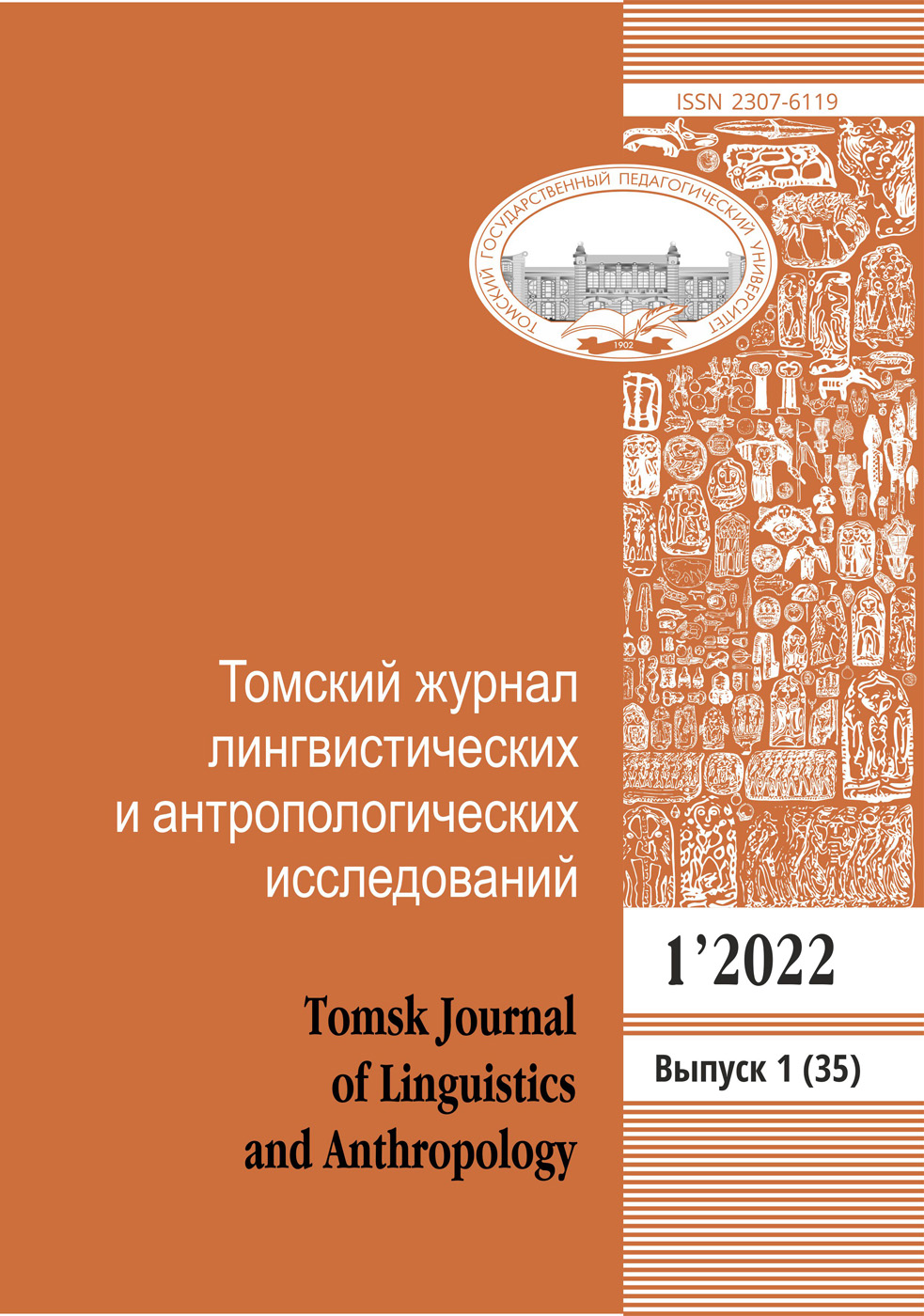ON THE FEATURES OF THE TRANSLATION OF GREEK COMPLEX WORDS IN THE INITIAL STAGES OF THE CHURCH SLAVONIC LITERATURE
DOI: 10.23951/1609-624X-2019-7-40-47
Introduction. Though the Church Slavonic composites have been thoroughly studied, many problems concerning the origin of this linguistic phenomenon in the early stages of Church Slavonic literature still remain open. Aim and Objectives. The purpose of this study is to analyze the methods of translating of Greek composites to the Church Slavonic language in the early stages of the history of Slavic literature (the end of the 9th - the beginning of the 10th centuries). Material and Methods. The investigation was performed on the base of the Slavonic translations of the Byzantine hymnography of the Triodion cycle. We studied comparatively with their Greek texts four Slavonic translated hymns: the Akathistos Hymn, the Great Canon of Repentance by St. Andrew of Crete, the Alphabetical Shichera from the Great Canon service and the Antiphons of the Great and Holy Friday by the Church Slavonic manuscripts (Lenten Triodion and Pentecostarion) of the 12th - 13th centuries. Results and discussion. In the Greek texts of these hymns we found 147 composites and analyzed the options for their translation by Slavic scribes in terms of their morphemic and syntactic structure and semantics. Based on the structure, Slavic correspondences to Greek composites were divided into untranslated borrowings, phrases, single-root semantic correspondences, original composites and calque-composites. Most of these categories were further divided into structural and semantic subcategories, with the different ways of reproducing of the semantics of the Greek composites. In percentage terms, the most insignificant category was borrowings. The calque technique actively used by Slavic scribes, however, covers less than a half of the total number of Slavic correspondences. We observed a considerable variation in the Slavic translations of Greek lexemes and root morphemes, while the same morpheme as a part of different composites could be translated as a single word, root or affix. Conclusion. The status of the calque in the early stages of the history of the Church Slavonic language was just one of the methods of conveying the semantics of a Greek composite, without a conscious intention of the scribes neither to copy the structure of the Greek words nor to establish invariant lexical, morphological and structural correspondences between the source and the target language.
Keywords: Church Slavonic language, composites, calque, hymnography, Lenten Triodion, Pentecostarion
References:
1. Panin L. G. Grecheskiy yazyk v istorii russkogo yazyka [Greek Language in the history of Russian Language]. Chelovek v kul’ture Antichnosti, Srednikh vekov i Vozrozhdeniya. Sbornik nauchnykh trudov v chest’ yubileya N. V. Revyakinoy [Man in the culture of Antiquity, Middle Ages and Renaissance. Collection of papers in honor of N. V. Revyakina]. Ivanovo, ISU Publ., 2006. Pp. 143–155 (in Russian).
2. Vereshchagin E. M. Iz istorii vozniknoveniya pervogo literaturnogo yazyka slavyan. Perevodcheskaya tekhnika Kirilla i Mefodiya [From the history of the origin of the first literature language of Slavs. Translation technique of Cyril and Methodius]. Moscow, MSU Publ., 1971. 255 p. (in Russian).
3. Averintsev S. S. Kreshcheniye Rusi i put’ russkoy kul’tury [Baptism of Russia and the way of Russian culture]. Simvol, 1988, no. 20, pp. 81–91 (in Russian).
4. Tseytlin R. M. Leksika staroslavyanskogo yazyka [Vocabulary of Church Slavonic language]. Moscow, Nauka Publ., 1977. 336 p (in Russian).
5. Novak M. O. O slavyano-grecheskikh parallelyakh composita v tekste Apostola [About the Greek-Slavonic parallel composite in the text of Apostol]. Istoriya russkogo yazyka: Slovoobrazovaniye i formoobrazovaniye [History of the Russian Language: word formation and declension]. Kazan, Unipress Publ., 1997. Pp. 170–178 (in Russian).
6. Chernysheva M. I. Semantika slovoobrazovatel’nykh modeley s nachal’nymi blago- i bogo- (Novyye dannyye) [Semantics of word formation models starting with Blago- and Bogo- (New data)]. Slavyanskoye yazykoznaniye. 14 Mezhdunarodnyy s”yezd slavistov. Okhrid, 10–16 sentyabrya 2008 g. Doklady rossiyskoy delegatsii [Slavic Linguistics. 14th International Congress on Slavistics. Okhrid, 10–16 September, 2008. Russian delegation lectures]. Moscow, 2008. Pp. 540–553 (in Russian).
7. Solomonovskaya A. L. Composita v tserkovnoslavyanskom perevode traktata Psevdo-Dionisiya Areopagita “O nebesnoy ierarkhii” [Composita in the Church Slavonic translation of the treatise by Pseudo-Dionysius Areopagit “On the Heavenly Hierarchy”]. Sibirskiy filologicheskiy zhurnal – Siberian Journal of Philology, 2012, no. 4, pp. 114–123 (in Russian).
8. Crvenkovska E. Jазыкот и стилот на Триодот [Language and Style of Triodion]. Skopjе, 2006. 302 p. (in Macedonian).
9. Trypanis C. A. Fourteen Early Byzantine Cantica. Vienna, 1968. 171 p.
10. Migne G. P. Patrologiae Cursus Graecae. Paris, 1860. Vol. 97.
11. Τριώδιον κατανυκτικὸν [Lenten Triodion]. Venice, 1867. 455 p (in Greek).
12. Borisova T. S. Tekstologiya tserkovnoslavyanskikh perevodov vizantiyskikh gimnograficheskikh tekstov po spiskamTriodi postnoy XII–XV vekov [Textology of Church Slavonic Translations of Byzantine Hymnography from the Lenten Triodion of 12–15th Centuries]. Novosibirsk, NSU Publ., 2016. 280 p. (in Russian).
13. Borisova T. The Great and Holy Friday Antiphons in the Early Ecclesiastical Slavonic Tradition: Comparative Analysis of the Troparia Composition. Fragmenta Hellinoslavica. Vol. 5. Thessaloniki, 2018. Pp. 57–82.
14. Ralli A. Compounding versus Derivation. Cross-Disciplinary Issues in Compounding. 2010. Pp. 57–74.
15. Αναστασιάδη- Συμεωνίδη Α. Το μόρφημα θεο- στην ελληνική [The morpheme theo- in Greek]. Γλώσσης χάριν. Τιμητικός τόμος Γ. Μπαμπινιώτη [In honor of G. Babiniotis]. Athens, Ellinika Grammata Publ., 2008. Pp. 99–113.
16. Averintsev S. S. ΕΥΣΠΛΑΧΝΙΑ [EYSPLAXNIA]. Istoriko-filologicheskiye issledovaniya. Sbornik statey pamyati akademika N. I. Konrada [History and philology researches. In memory of academician N. I. Konrad]. Moscow, 1974. Pp. 161–170 (in Russian).
Issue: 7, 2019
Series of issue: Issue 7
Rubric: TOPICAL ISSUES OF DISCOURSIVE LINGUISTICS
Pages: 40 — 47
Downloads: 571





